

|

|
The view left is taken looking NE from O'Briens tower, the highest point of Inis Oírr (Inisheer), the smallest of the Aran Islands, immortalised in the opening sequences of Father Ted, which you can view on YouTube - Father Ted Opening. It gives a feel for just how densely populated by walls these islands are.
The view from within fields on the flatter parts of the islands is often little more than one wall merging into another as on Inis Mór right.
Initial research threw up the 'fact' in "The Telegraph" that Inis Mór has an estimated 3000 miles of wall. As Inis Mór is around 7600 acres back of an envelope calculations suggested this would provide for an average distance between walls (in any direction) of around 14 yards. Another source www.aran-isles.com claims "The surface of the [3] islands is about 18 square miles, but there are more than 5,000 miles of wall", suggesting a greater density.
It is sometimes said that if the walls on Aran were joined they would stretch all the way to Boston. Robinson (Labyrinth p.11)attributes this claim to islanders relating to all three islands. As Boston is around 2900 miles from Aran this might explain some of the 'theories'. Dealing with the islands can be confusing as in Irish gaelic together they are Árann, but Inis Mór is also known as Árainn. This might explain some of the exaggerated claims, it doesn't excuse them
Robinson provides the most scientific analysis I have found, suggesting around 900 miles on Inis Mór and about 1500 in total for the 3 islands (Labyrinth. P.11). I am still a little sceptical as it still seems to over egg the cake somewhat. My own estimates, somewhat empirically based and highly questionable come up with something less than 700 miles for Inis Mór.
Whatever the actual mileage is, it's a lot and at a density almost certainly unmatched elsewhere. But within the overall context of walling treasures if a large part of the reason for a nomination is the sheer quantity, the actual quantity is of some relevance.
I shall endeavour to take this further... watch this space.
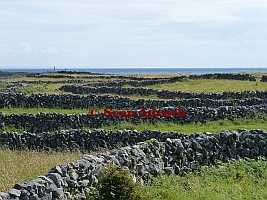
|
The fields are subsequently tiny due to scale of labour - essentially you could only reclaim a small area at a time. This you would clear of stone, building walls from the excess. These walls would also offer protection from the wind, reducing the likelihood of the soil being blown away. Smaller fields, more walls, greater protection. This is likely to at least part explain the plethora of small fields around the villages and the eastern coastal strip (as illustrated left) in general. A situation that in all likelihood was exacerbated by Ireland's history of divided inheritance
Aran's one 'major' industry of the past was seaweed (primarily kelp) gathering and processing (producing ash rich in iodine to export for fertilisers and chemical feedstock.) More recently there has been limited sea-rod (another seaweed) collecting, with the coastal walls important for hanging the fronds to dry (Robinson, Labyrinth p.173). It is not clear whether the walls were originally built for this purpose or their presence merely taken advantage of..

|

|
Grazing? On Inis Mór we only saw 30 or 40 horses (there's a thriving trade in cart rides for tourists), half a dozen goats, probably no more than 100 head of cattle and absolutely no sheep (thriving sweater industry?). This survey was hardly scientific, but on a relatively flat island there are only so many places you can hide stock from someone who spends a week cycling around every road and track, seemingly photographing every wall in sight!
There have in fact been a number of articles on the sweater industry which bemoan the lack of sheep, although on Inis Mór I would suggest the walls are generally lower than those on Inis Oírr (the smallest island which we visited very briefly) and hardly conducive to sheep farming. Another conundrum, plus it doesn't necessarily follow that the idea of smaller fields for better grazing management means postage stamp sized fields; unless you have only one or two head, otherwise you just spend more time moving everything, even then why so many fields?
It is likely that Aran's agriculture has always been at a subsistence level. Royle (p.80) suggests that in the 1820s most grew potatoes as a basic foodstuff, kept a couple of cows and produced calves to sell on to the mainland. The one benefit the island has is relatively mild, essentially frost free winters and year round grazing. Furthermore Robinson (Labyrinth p.22) suggests the pavements are good for over-wintering stock, their free draining nature making them ideal underfoot. Aran has thus always served as a winter home for Connemara cattle. He also suggests the absence of stock from the pavement in summer is a result of warble fly problems and the cattle's tendency to gallop madly when bitten, and hence likely to break a leg in the grykes.
Aran's one 'major' industry of the past was seaweed (primarily kelp) gathering and processing (producing ash rich in iodine to export for fertilisers and chemical feedstock.) More recently there has been limited sea-rod (another seaweed) collecting, with the coastal walls important for hanging the fronds to dry (Robinson, Labyrinth p.173). It is not clear whether the walls were originally built for this purpose or their presence merely taken advantage of.

|
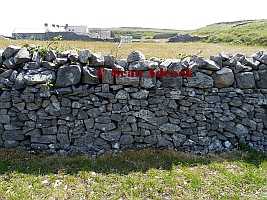
|
Almost without exception these walls have a level block cope with the wall height varied to accomodate varying block sizes.
Apart from flat/block cope most walls seemingly peter out, although sometimes the top is reasonably level as you would expect to find with the singles and Galloways of Scotland. It is of course possible that the less level tops have just degraded over time.

|
The origin of Aran's walls is of course lost in the mists of time and they are of largely indeterminant age. There do not appear to be any professional wallers on the islands per se, rather its something many turn their hands to. This said given the mileage of wall they are in remarkably good condition. This is most likely due to the fact that many are sitting on bedrock and hence settlement does not really enter the equation.
The pattern of walls varies as does the limestone with blockier walls and slabbier ones inter alia. Generally there appears litte rhyme or reason to the patterns. Robinson (Labyrinth p.14) suggests many of the walls nearer the settlements have at least a doubled bottom as this would make them more rabbit proof than the lace-walls which are better for more exposed parts where they offer better protection from the wind (solid walls tend to create vortexes.
As you would expect with several hundred miles of wall they are far from uniform.
Aran has many lace-walls, single stone thick walls which are essentially see through. Similar walls can be found on the nearby Burren, and some parts of Scotland and New England synonymous with limestone areas of Western Ireland. On Inis Mór they are widespread(although they do predominate in the more exposed southern parts of the island) across the island coming in a variety of shapes and sizes, wihout particular rhyme or reason. Their nature is pobably utilitarian, their pattern determined by a combination of whatever came to hand with as little effort as reasonably practical, and the whim of the individual builder, probably tempered by tradition .
Single walls form a walling treasure in their own right and can be found elsewhere on this site

|
The term Aran Gap is one others appear to have adopted, although with varying interpretations/levels of understanding. Rick Steves (www.ricksteves.com) calls all single lace-walls 'Aran gap style', probably believing that all singles are built so that you can take down any part at will, just piling it back afterwards. After all we all know how easy single walling is!! People generally do not realise how stable these walls are and even if you did regularly dismantle them more formalised gaps would develop at regular access points. That said Robinson (Labyrinth p.13) relates that in 1869 a botanist employed a local to push them down so he could get fro A to B more conveniently during his field studies.
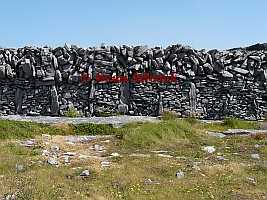
|
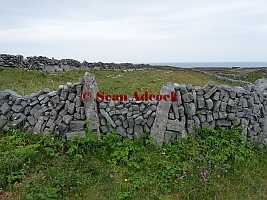
|
It is always possible that the botanist did not realise the local was pushing through Bearna. If you look closely at the photo left, there is a Bearna behind the copyright symbol. A fact I had not realised when taking the photo.
The gaps vary in pattern, the edges are frequently sloping slabs as in the photo right, sometimes a more formal end or just large stones stepped slightly (below left). Fitzgerald (p.68) suggests they are filled with rounded stones (below second from left) so that they are easy to push over and rebuild. This is probably a misconception as this tends only to be nearer the coast, and they are still reasonably stable. Practically it is maybe as likely that they are just utilising the least suitable wall building stone. Robinson admits that when he first identified the Bearna and wrote about them he too thought they were all rounded Labyrinth p.17. (it is possible that Fitgerald was thus influenced) easing their dismantling adding the interesting idea that granite withstood the repeated dismantling better. Perhaps the mistaken belief that they are all made of rounded stone is because until you become accustomed to them you cannot see the wood for the trees so to speak or more pertinently 'the gap for the stone', whereas the boulders stand out like sore thumbs. One final corllary from Robinson is that he suggests that traditionally "a short length of briar or a blackthorn branch is wedged among its topmost stones to discourage cattleor horses from nosing it down" (Labyrinth p.13).
Even a well built "singled" gap would not take long to dismantle. It's more to do with the number of stones than their shape, if you just push it over you would still usually need to clear the stone to the sides.
It seems likely that the use of stone to fill gaps was largely a result of a lack of practical alternatives particularly the lack of wood on the islands, although Evans suggests that these "phantom gates" are more to do with shelter from the wind ("Irish Folk Ways", Evans E, Routledge 1957 cited by Brooks (p.7), although this hardly seems compelling.
The bearna are not confined to low walls, the one shown above right (both sides) on Inis Oírr was over 6 feet high.
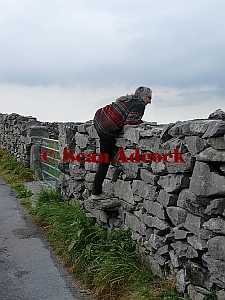
|
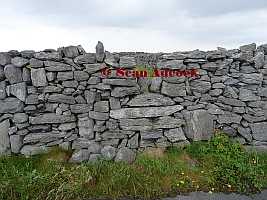
|
Human access isn't entirely about gaps. If you look closely many of the bearna have simple stiles, or a very long projecting through (not common in the walls in gerneral) close-by to ease access if not particularly designed for ease of passage.
Robinson (Labyrinth p.329) suggests what he calls the 'ordinary Aran stile' known as staighre (literally stairs) has 2 or 3 projecting throughs and is used between fields on a single holding. Although in our limited experience we found that without exception these were just single steps. He also identifies a public right of way stile which he descibes as a semi-squeeze stile and calls céimín (little step. These, such as this example on Inis Oírr (right)are relatively few and far between.
In the background of the photo left you can see that the gap has been replaced by a conventional gate. I suppose you can be forgiven for some modernisation when confronted with de facto solid walls every day of your farming life. Nearer the settlements opening the gap and using pallets as semi-permanent gates seems the preferred method (in one place we actually found a pallet hinged to a wooden gatepost). In many instances stone is just piled to side to allow several fields to be grazed at once. This is likely to have ever been the case, although as you might expect there is evidence that a number of the gaps are widening through neglect.
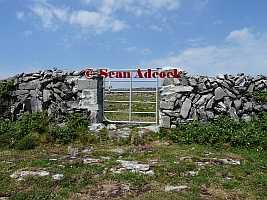
|